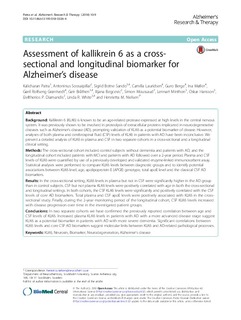| dc.contributor.author | Patra, Kalicharan | |
| dc.contributor.author | Soosaipillai, Antoninus | |
| dc.contributor.author | Sando, Sigrid Botne | |
| dc.contributor.author | Lauridsen, Camilla | |
| dc.contributor.author | Berge, Guro | |
| dc.contributor.author | Møller, Ina | |
| dc.contributor.author | Grøntvedt, Gøril Rolfseng | |
| dc.contributor.author | Bråthen, Geir | |
| dc.contributor.author | Begcevic, Ilijana | |
| dc.contributor.author | Moussaud, Simon | |
| dc.contributor.author | Minthon, Lennart | |
| dc.contributor.author | Hansson, Oskar | |
| dc.contributor.author | Diamandis, Eleftherios P. | |
| dc.contributor.author | White, Linda Rosemary | |
| dc.contributor.author | Nielsen, Henrietta M. | |
| dc.date.accessioned | 2019-03-22T08:12:01Z | |
| dc.date.available | 2019-03-22T08:12:01Z | |
| dc.date.created | 2018-07-08T14:01:01Z | |
| dc.date.issued | 2018 | |
| dc.identifier.citation | Alzheimer's Research & Therapy. 2018, 10:9 1-11. | nb_NO |
| dc.identifier.issn | 1758-9193 | |
| dc.identifier.uri | http://hdl.handle.net/11250/2591201 | |
| dc.description.abstract | Background
Kallikrein 6 (KLK6) is known to be an age-related protease expressed at high levels in the central nervous system. It was previously shown to be involved in proteolysis of extracellular proteins implicated in neurodegenerative diseases such as Alzheimer’s disease (AD), prompting validation of KLK6 as a potential biomarker of disease. However, analyses of both plasma and cerebrospinal fluid (CSF) levels of KLK6 in patients with AD have been inconclusive. We present a detailed analysis of KLK6 in plasma and CSF in two separate cohorts in a cross-sectional and a longitudinal clinical setting.
Methods
The cross-sectional cohort included control subjects without dementia and patients with AD, and the longitudinal cohort included patients with MCI and patients with AD followed over a 2-year period. Plasma and CSF levels of KLK6 were quantified by use of a previously developed and validated enzyme-linked immunosorbent assay. Statistical analyses were performed to compare KLK6 levels between diagnostic groups and to identify potential associations between KLK6 level, age, apolipoprotein E (APOE) genotype, total apoE level and the classical CSF AD biomarkers.
Results
In the cross-sectional setting, KLK6 levels in plasma but not in CSF were significantly higher in the AD group than in control subjects. CSF but not plasma KLK6 levels were positively correlated with age in both the cross-sectional and longitudinal settings. In both cohorts, the CSF KLK6 levels were significantly and positively correlated with the CSF levels of core AD biomarkers. Total plasma and CSF apoE levels were positively associated with KLK6 in the cross-sectional study. Finally, during the 2-year monitoring period of the longitudinal cohort, CSF KLK6 levels increased with disease progression over time in the investigated patient groups.
Conclusions
In two separate cohorts we have confirmed the previously reported correlation between age and CSF levels of KLK6. Increased plasma KLK6 levels in patients with AD with a more advanced disease stage suggest KLK6 as a potential biomarker in patients with AD with more severe dementia. Significant correlations between KLK6 levels and core CSF AD biomarkers suggest molecular links between KLK6 and AD-related pathological processes. | nb_NO |
| dc.language.iso | eng | nb_NO |
| dc.publisher | BioMed Central | nb_NO |
| dc.rights | Navngivelse 4.0 Internasjonal | * |
| dc.rights.uri | http://creativecommons.org/licenses/by/4.0/deed.no | * |
| dc.title | Assessment of kallikrein 6 as a cross-sectional and longitudinal biomarker for Alzheimer's disease | nb_NO |
| dc.type | Journal article | nb_NO |
| dc.type | Peer reviewed | nb_NO |
| dc.description.version | publishedVersion | nb_NO |
| dc.source.pagenumber | 1-11 | nb_NO |
| dc.source.volume | 10:9 | nb_NO |
| dc.source.journal | Alzheimer's Research & Therapy | nb_NO |
| dc.identifier.doi | 10.1186/s13195-018-0336-4 | |
| dc.identifier.cristin | 1596239 | |
| dc.description.localcode | © The Author(s). 2018. This article is distributed under the terms of the Creative Commons Attribution 4.0 International License (http://creativecommons.org/licenses/by/4.0/), which permits unrestricted use, distribution, and reproduction in any medium, provided you give appropriate credit to the original author(s) and the source, provide a link to the Creative Commons license, and indicate if changes were made. | nb_NO |
| cristin.unitcode | 194,65,30,0 | |
| cristin.unitname | Institutt for nevromedisin og bevegelsesvitenskap | |
| cristin.ispublished | true | |
| cristin.fulltext | original | |
| cristin.qualitycode | 1 | |

